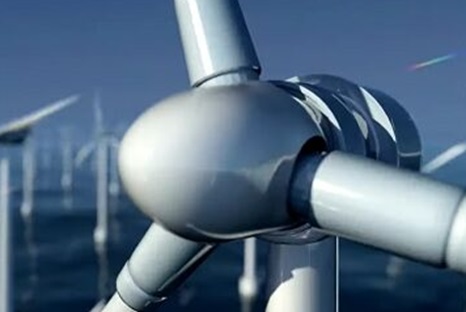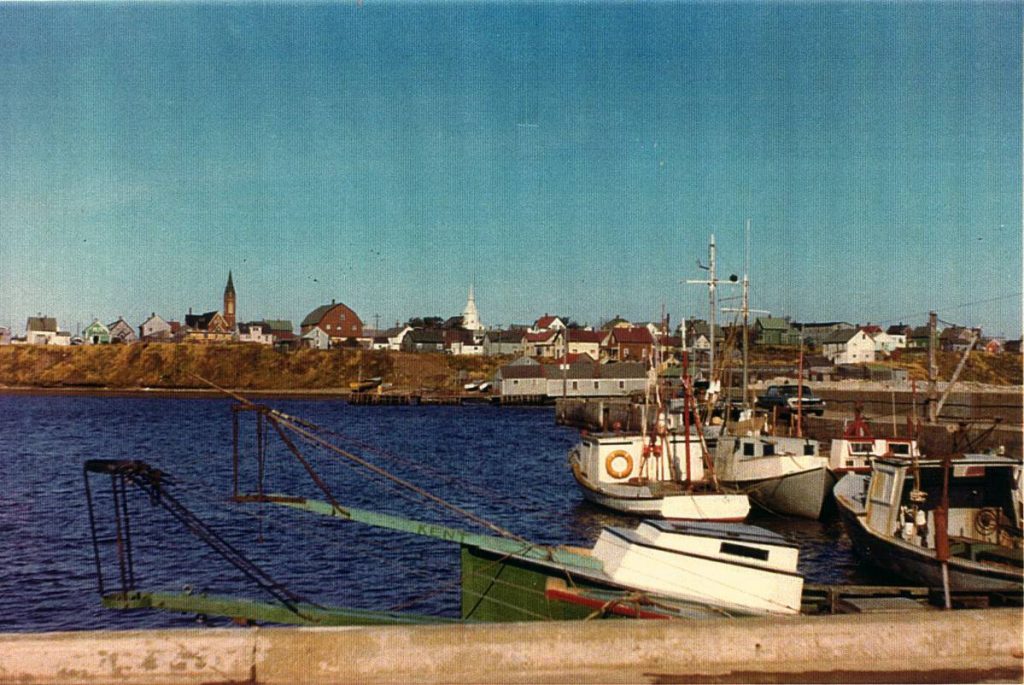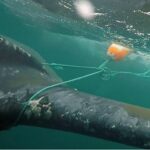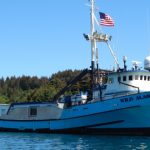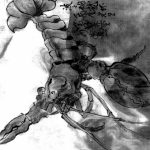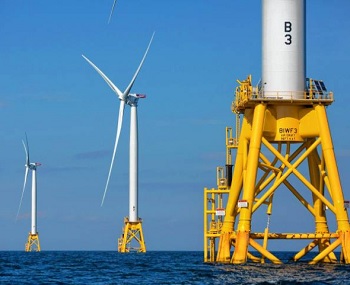 The massive blade that broke off a windmill tower, splashed down into the ocean and had pieces wash up on Nantucket beaches a few weeks ago is having repercussions here today in Connecticut. The joint venture project being developed by a division of Orange-based Avangrid and a Dutch renewable energy company is under scrutiny, even as construction of the 806-megawatt offshore wind farm came to halt in mid-July when a 300-foot section of a 360-foot blade broke off one of the turbines that are part of Vineyard Wind. The project, which is a joint venture of Avangrid Renewables and Copenhagen Infrastructure Partners, is being developed about 15 miles south of Martha’s Vineyard and Nantucket, and 35 miles from mainland Massachusetts. more, >>CLICK TO READ<< 10:29
The massive blade that broke off a windmill tower, splashed down into the ocean and had pieces wash up on Nantucket beaches a few weeks ago is having repercussions here today in Connecticut. The joint venture project being developed by a division of Orange-based Avangrid and a Dutch renewable energy company is under scrutiny, even as construction of the 806-megawatt offshore wind farm came to halt in mid-July when a 300-foot section of a 360-foot blade broke off one of the turbines that are part of Vineyard Wind. The project, which is a joint venture of Avangrid Renewables and Copenhagen Infrastructure Partners, is being developed about 15 miles south of Martha’s Vineyard and Nantucket, and 35 miles from mainland Massachusetts. more, >>CLICK TO READ<< 10:29
Tag Archives: GE Vernova

The largest offshore wind energy farm causes shock: The strange effect caused by one of its turbines
The Dogger Bank Wind Farm, planned to be the largest offshore wind farm worldwide, recently became the news headline, but not in the way expected. Notably, a recent major failure of turbines has caused people to pay attention to the project and ask questions. On August 22, a catastrophic blade failure was experienced on one of the turbines at the Dogger Bank A section, which is still under construction. GE Vernova, the manufacturer of the turbines, said that this failure was not due to installation or manufacturing defects but occurred during the commissioning process. The Dogger Bank incident is similar to a blade problem in the year at a turbine owned by GE Vernova in the United States. These recurrent problems indicate that manufacturers and engineers must enhance the installation procedure and working standards to achieve turbine durability. more, >>CLICK TO READ<< 07:445
More Vineyard Wind blades must be removed, repaired
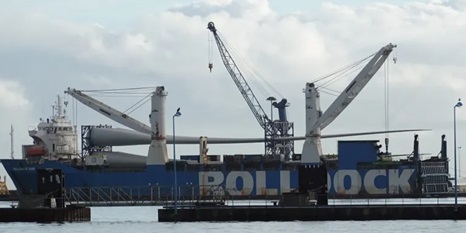 Vineyard Wind must remove an unknown number of blades that have already been installed south of Martha’s Vineyard while it repairs others, the company announced Wednesday. The project also received permission from the federal government this week to resume blade installation after it removes and repairs the components in the coming weeks. The latest announcement suggests investigations found more defective blades similar to the blade that failed in July and comes after the project quietly delivered at least four turbine blades from New Bedford to Cherbourg, France, where GE Vernova operates a blade manufacturing plant. >more, >>CLICK TO READ<< 11:48
Vineyard Wind must remove an unknown number of blades that have already been installed south of Martha’s Vineyard while it repairs others, the company announced Wednesday. The project also received permission from the federal government this week to resume blade installation after it removes and repairs the components in the coming weeks. The latest announcement suggests investigations found more defective blades similar to the blade that failed in July and comes after the project quietly delivered at least four turbine blades from New Bedford to Cherbourg, France, where GE Vernova operates a blade manufacturing plant. >more, >>CLICK TO READ<< 11:48
Pickup of seabed debris at Vineyard Wind broken turbine underway
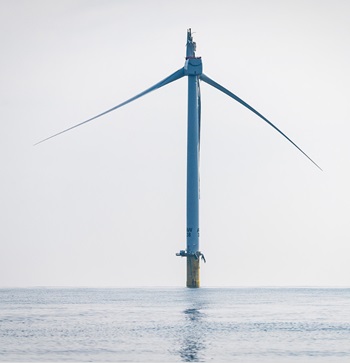 Work is underway to recover debris that sank to the seafloor below Vineyard Wind’s AW-38 turbine when the blade broke apart in July, according to GE Vernova, the company that manufactures and installs the turbine parts. Efforts began on Sunday and were ongoing as of Tuesday afternoon. It’s been three months since one of the three football field-sized blades on turbine AW-38 collapsed, sending pieces of fiberglass, rigid foam and balsawood crashing into the ocean. Large pieces immediately sank, but other debris of varying sizes washed ashore on Nantucket, Martha’s Vineyard, parts of Cape Cod and along Narragansett Bay for weeks afterwards. Some beach walkers are still reporting finding small remnants. more, >>CLICK TO READ<< 13:33
Work is underway to recover debris that sank to the seafloor below Vineyard Wind’s AW-38 turbine when the blade broke apart in July, according to GE Vernova, the company that manufactures and installs the turbine parts. Efforts began on Sunday and were ongoing as of Tuesday afternoon. It’s been three months since one of the three football field-sized blades on turbine AW-38 collapsed, sending pieces of fiberglass, rigid foam and balsawood crashing into the ocean. Large pieces immediately sank, but other debris of varying sizes washed ashore on Nantucket, Martha’s Vineyard, parts of Cape Cod and along Narragansett Bay for weeks afterwards. Some beach walkers are still reporting finding small remnants. more, >>CLICK TO READ<< 13:33
Broken blades, angry fishermen, and rising costs slow offshore wind
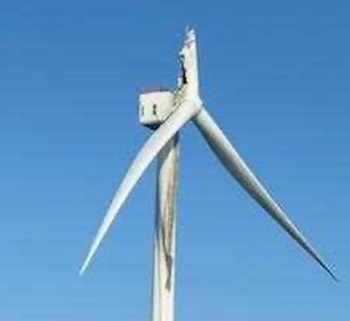 The collapse of a giant wind turbine blade off the Massachusetts coast confirmed Peter Kaizer’s worst fears about the dangers a new clean energy business could pose to fishermen like him. Jagged pieces of fiberglass and other materials from the shattered blade drifted with the tide, forcing officials to close beaches on Nantucket and leaving Kaizer worried about the threat the fragments might pose to his vessel and other fishing boats, especially at night when the debris would be harder to avoid. “All these small boats could be subject to damage,” Kaizer said. “Everyone wants this green legacy, but at the cost of what?” Full article. more, >>CLICK TO READ<< 07:58
The collapse of a giant wind turbine blade off the Massachusetts coast confirmed Peter Kaizer’s worst fears about the dangers a new clean energy business could pose to fishermen like him. Jagged pieces of fiberglass and other materials from the shattered blade drifted with the tide, forcing officials to close beaches on Nantucket and leaving Kaizer worried about the threat the fragments might pose to his vessel and other fishing boats, especially at night when the debris would be harder to avoid. “All these small boats could be subject to damage,” Kaizer said. “Everyone wants this green legacy, but at the cost of what?” Full article. more, >>CLICK TO READ<< 07:58
Turbine blade fails on Dogger Bank installation
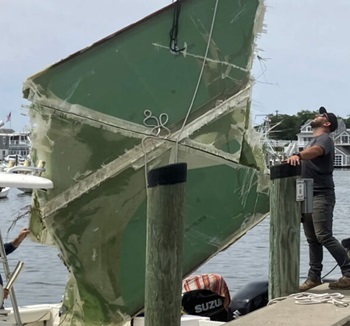 Reports of the failure of a 107m long wind turbine blade during commissioning of the Dogger Bank wind farm – the world’s largest – have been confirmed by the operators. They remain tight- lipped, however, about any detail of the incident. The blade was built by GE Vernova, and is of the same design as the one that failed spectacularly in the Vineyard Wind development off the east coast of the USA in July, where thousands of sharp fragments of the blade washed up on nearby tourist beaches, leading to them being closed for several days during an emergency clean-up. Last week’s incident on the Dogger Bank was the third for this particular type of blade in three months. An earlier failure at the same site in May was, said GE Vernova at the time, ‘the result of an installation failure’. more, >>CLICK TO READ<< 10:44
Reports of the failure of a 107m long wind turbine blade during commissioning of the Dogger Bank wind farm – the world’s largest – have been confirmed by the operators. They remain tight- lipped, however, about any detail of the incident. The blade was built by GE Vernova, and is of the same design as the one that failed spectacularly in the Vineyard Wind development off the east coast of the USA in July, where thousands of sharp fragments of the blade washed up on nearby tourist beaches, leading to them being closed for several days during an emergency clean-up. Last week’s incident on the Dogger Bank was the third for this particular type of blade in three months. An earlier failure at the same site in May was, said GE Vernova at the time, ‘the result of an installation failure’. more, >>CLICK TO READ<< 10:44
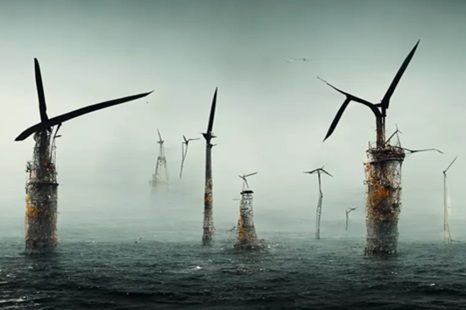
U.S. Offshore Wind: The Struggle Continues
This post updates the financial troubles of Denmark’s Ørsted, recent BOEM auctions, and pushback against Maryland governor Wes Moore. Today, operational offshore wind capacity is less than 50 megawatts versus the Biden-Harris Administration goal of 30,000 MW by 2030. Denmark’s Ørsted, the worldwide leading offshore wind developer, recorded a $575 million loss in the second quarter. In part, the loss is the result of disappointing developments in the U.S. The company has delayed commercial operation of its 704-MW Revolution Wind project off the coast of Rhode Island and Connecticut from 2025 to 2026. Ørsted’s ambitious U.S. offshore wind program has been lagging, despite solid support (subsidies, permits) from the Biden administration. more, >>CLICK TO READ<< 06;50
Shattered Wind Blade Puts Nantucket on Frontlines of a Clean-Energy Fight
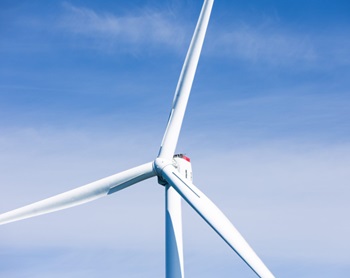 Weeks after a busted wind turbine washed onto Nantucket shores, residents of this wealthy Massachusetts enclave are still angry. Some even liken the accident to an oil spill. While their ire belies the fleeting nature of the event — waters were re-opened for swimming within 24 hours — the sense of harm felt by the community threatens to cast a long shadow. Vineyard Wind’s project south of Nantucket is the fledgling industry’s marquee venture, heralding a massive buildout of wind energy that would provide coastal cities with zero-carbon electricity. What happens here could have implications for a raft of other projects planned off Martha’s Vineyard, Atlantic City and elsewhere on the Eastern seaboard. “The great Nantucket experiment gets an F-minus,” says Kevin O’Leary, chairman of O’Leary Ventures and an investor on the reality show Shark Tank who visits Nantucket every summer. “It’s not a golden example of success in wind turbines, that’s for sure.” more, >>CLICK TO READ<< 08:24
Weeks after a busted wind turbine washed onto Nantucket shores, residents of this wealthy Massachusetts enclave are still angry. Some even liken the accident to an oil spill. While their ire belies the fleeting nature of the event — waters were re-opened for swimming within 24 hours — the sense of harm felt by the community threatens to cast a long shadow. Vineyard Wind’s project south of Nantucket is the fledgling industry’s marquee venture, heralding a massive buildout of wind energy that would provide coastal cities with zero-carbon electricity. What happens here could have implications for a raft of other projects planned off Martha’s Vineyard, Atlantic City and elsewhere on the Eastern seaboard. “The great Nantucket experiment gets an F-minus,” says Kevin O’Leary, chairman of O’Leary Ventures and an investor on the reality show Shark Tank who visits Nantucket every summer. “It’s not a golden example of success in wind turbines, that’s for sure.” more, >>CLICK TO READ<< 08:24
Crawlers to Inspect Blades After Vineyard Wind Failure
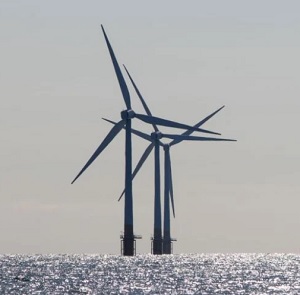 Vineyard Wind and GE Vernova on Friday released a plan outlining the steps to be followed after a turbine blade failure last month at the Vineyard Wind offshore project off the coast of Massachusetts, which left potentially dangerous debris on beaches on the island of Nantucket. Vineyard Wind, the first major U.S. offshore wind farm, was shut down by federal authorities after the turbine blade failure. The plan outlines the steps to be followed to recover the remainder of the blade on the turbine. It has been developed in consultation the U.S. Bureau of Safety and Environmental Enforcement and the U.S. Coast Guard, the companies said in a statement. more, >>CLICK TO READ<< 06:47
Vineyard Wind and GE Vernova on Friday released a plan outlining the steps to be followed after a turbine blade failure last month at the Vineyard Wind offshore project off the coast of Massachusetts, which left potentially dangerous debris on beaches on the island of Nantucket. Vineyard Wind, the first major U.S. offshore wind farm, was shut down by federal authorities after the turbine blade failure. The plan outlines the steps to be followed to recover the remainder of the blade on the turbine. It has been developed in consultation the U.S. Bureau of Safety and Environmental Enforcement and the U.S. Coast Guard, the companies said in a statement. more, >>CLICK TO READ<< 06:47
CT-based Avangrid wind farm under scrutiny, energy production halted, after blade shatters.
Federal regulators issue revised suspension order for Vineyard Wind as more debris falls from damaged turbine
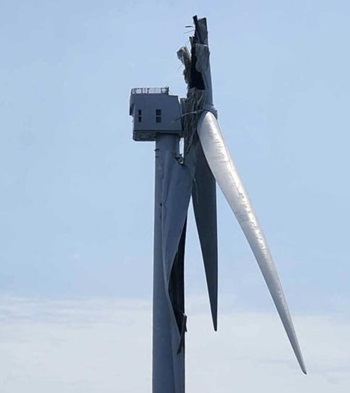 “This maintenance work has already begun, reinforcing the stability and security of the turbines,” Nantucket officials said in an update on the town’s website. The BSEE said it will publicly release the findings of its investigation when it is complete. Fiberglass debris from the damaged turbine has continued to fall into the ocean in recent days. Nantucket officials said “several sections” of the damaged blade detached from the hub and sank to the ocean floor on Monday. Town officials said the debris “primarily consists of small, popcorn-sized pieces of foam, with some larger pieces and limited fiberglass fragments possibly mixed in.” Vineyard Wind crews were collecting debris from the water on Tuesday but warned that some debris may wash onto Nantucket’s southern beaches Wednesday and Thursday, town officials said. more, >>CLICK TO READ<< 10:24
“This maintenance work has already begun, reinforcing the stability and security of the turbines,” Nantucket officials said in an update on the town’s website. The BSEE said it will publicly release the findings of its investigation when it is complete. Fiberglass debris from the damaged turbine has continued to fall into the ocean in recent days. Nantucket officials said “several sections” of the damaged blade detached from the hub and sank to the ocean floor on Monday. Town officials said the debris “primarily consists of small, popcorn-sized pieces of foam, with some larger pieces and limited fiberglass fragments possibly mixed in.” Vineyard Wind crews were collecting debris from the water on Tuesday but warned that some debris may wash onto Nantucket’s southern beaches Wednesday and Thursday, town officials said. more, >>CLICK TO READ<< 10:24
Vineyard Wind Resumes Some Construction During Investigation
 Though pieces of the broken Vineyard Wind turbine continued to fall into the ocean south of the Island this week, federal regulators have approved the wind farm to restart some construction work. On Monday, several sections of the malfunctioning turbine blade that were still attached to the turbine split off and sunk to the ocean floor. Boats were dispatched to the area and both GE Vernova, the turbine manufacturer, and Vineyard Wind were working to clean up the blade pieces and popcorn-sized chunks of styrofoam that had spread into the water. While Vineyard Wind cannot generate any power from the turbines, the company has turned to other work around the rest of the planned 62-turbine wind farm with the blessing of the federal government. The Bureau of Safety and Environmental Enforcement, which oversees offshore wind projects in the U.S., had previously said operations at the wind farm 14 miles south of the Vineyard had shut down until further notice after the 107-meter turbine blade broke. On Saturday, the federal agency clarified that Vineyard Wind could do some work not directly connected to the turbines, such as installing cables in the sea floor. Photos, more, >>CLICK TO READ<< 16:05
Though pieces of the broken Vineyard Wind turbine continued to fall into the ocean south of the Island this week, federal regulators have approved the wind farm to restart some construction work. On Monday, several sections of the malfunctioning turbine blade that were still attached to the turbine split off and sunk to the ocean floor. Boats were dispatched to the area and both GE Vernova, the turbine manufacturer, and Vineyard Wind were working to clean up the blade pieces and popcorn-sized chunks of styrofoam that had spread into the water. While Vineyard Wind cannot generate any power from the turbines, the company has turned to other work around the rest of the planned 62-turbine wind farm with the blessing of the federal government. The Bureau of Safety and Environmental Enforcement, which oversees offshore wind projects in the U.S., had previously said operations at the wind farm 14 miles south of the Vineyard had shut down until further notice after the 107-meter turbine blade broke. On Saturday, the federal agency clarified that Vineyard Wind could do some work not directly connected to the turbines, such as installing cables in the sea floor. Photos, more, >>CLICK TO READ<< 16:05
Massachusetts political contributions from Nantucket wind farm developer scrutinized
 As Nantucket continues to reel from the Vineyard Wind turbine blade failure, critics are raising concerns around how the project’s parent company, Avangrid, has donated thousands of dollars in campaign money to state elected officials. A Herald analysis found that employees who list Avangrid as their employer have made 217 donations totaling $57,677 to dozens of state and local campaigns since March 2018, two months before the Baker administration selected a Vineyard Wind bid for contract negotiation. Notable figures include project supporters Gov. Maura Healey receiving 38 donations totaling $16,425 since 2018, and state Sen. Julian Cyr, a Democrat whose district represents the Cape and Islands, collecting 17 contributions for $3,036 since 2021, according to the state Office of Campaign and Political Finance. more, >>CLICK TO READ<< 08:29
As Nantucket continues to reel from the Vineyard Wind turbine blade failure, critics are raising concerns around how the project’s parent company, Avangrid, has donated thousands of dollars in campaign money to state elected officials. A Herald analysis found that employees who list Avangrid as their employer have made 217 donations totaling $57,677 to dozens of state and local campaigns since March 2018, two months before the Baker administration selected a Vineyard Wind bid for contract negotiation. Notable figures include project supporters Gov. Maura Healey receiving 38 donations totaling $16,425 since 2018, and state Sen. Julian Cyr, a Democrat whose district represents the Cape and Islands, collecting 17 contributions for $3,036 since 2021, according to the state Office of Campaign and Political Finance. more, >>CLICK TO READ<< 08:29
Broken Turbine Blade Near Nantucket Prompts a ‘Told You So!’
 A broken turbine blade in the Vineyard Wind offshore wind farm led federal officials to suspend its operations in Nantucket. The incident resulted in large and small fiberglass and foam pieces from the turbine blade washing ashore on Nantucket’s southern beaches, more than 15 miles away. On Thursday, July 25, Cape May County released a statement by Commissioner Director Leonard Desiderio calling the incident in Massachusetts “an environmental catastrophe akin to an oil spill.” Desiderio said that “we were right to oppose offshore wind,” referencing the county’s strong opposition to the Danish firm Orsted’s plans for Ocean Wind I and II off the southern New Jersey coast. He added, “We will continue our opposition moving forward.” Desiderio’s statement recapped the county’s actions in opposition to the Orsted wind farm projects. He took pains to say that opposition by the county government was never based on a denial of climate change or incentivized by the oil industry. “Our opposition to offshore wind was always about protecting our local economy, our fishing industry and our way of life,” he said. more, >>CLICK TO READ<< 11:08
A broken turbine blade in the Vineyard Wind offshore wind farm led federal officials to suspend its operations in Nantucket. The incident resulted in large and small fiberglass and foam pieces from the turbine blade washing ashore on Nantucket’s southern beaches, more than 15 miles away. On Thursday, July 25, Cape May County released a statement by Commissioner Director Leonard Desiderio calling the incident in Massachusetts “an environmental catastrophe akin to an oil spill.” Desiderio said that “we were right to oppose offshore wind,” referencing the county’s strong opposition to the Danish firm Orsted’s plans for Ocean Wind I and II off the southern New Jersey coast. He added, “We will continue our opposition moving forward.” Desiderio’s statement recapped the county’s actions in opposition to the Orsted wind farm projects. He took pains to say that opposition by the county government was never based on a denial of climate change or incentivized by the oil industry. “Our opposition to offshore wind was always about protecting our local economy, our fishing industry and our way of life,” he said. more, >>CLICK TO READ<< 11:08
GE Vernova finds Manufacturing Defect after Vineyard Wind Turbine Accident
 The company is facing scrutiny after a massive blade fell into the ocean July 13 at the project in Massachusetts, stopping construction at the nation’s biggest offshore wind farm. Strazik said there’s no sign of a design flaw in its Haliade-X offshore turbine, but it’s halting production at the Gaspe, Canada, plant while the company inspects its blades. “The blade left the factory with insufficient bonding — the glue,” Strazik said. The Gaspe plant in Quebec has been in production since 2006 and has made about 150 offshore blades, including most of the blades for the Vineyard Wind project that experienced the blade failure. Strazik declined to say how many offshore blades have been produced to date at the company’s three blade plants. more, >>CLICK TO READ<< 08:07
The company is facing scrutiny after a massive blade fell into the ocean July 13 at the project in Massachusetts, stopping construction at the nation’s biggest offshore wind farm. Strazik said there’s no sign of a design flaw in its Haliade-X offshore turbine, but it’s halting production at the Gaspe, Canada, plant while the company inspects its blades. “The blade left the factory with insufficient bonding — the glue,” Strazik said. The Gaspe plant in Quebec has been in production since 2006 and has made about 150 offshore blades, including most of the blades for the Vineyard Wind project that experienced the blade failure. Strazik declined to say how many offshore blades have been produced to date at the company’s three blade plants. more, >>CLICK TO READ<< 08:07
How the death of a mega-turbine rattled US offshore wind
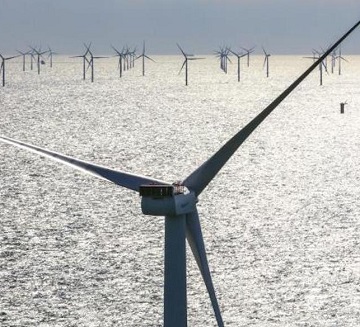 When GE Vernova confirmed that it was canceling one of the largest wind turbines ever designed, it signaled a pause in an arms race that for years had led manufacturers to go higher, longer and wider when building towers, blades and other components. Now, that decision is reverberating across U.S. efforts to build wind projects in the Atlantic. New York canceled power contracts for three offshore wind projects last week, citing GE Vernova’s decision to abandon its largest turbine model, a massive 18-megawatt machine. The timing could hardly be worse. Offshore wind is the keystone of New York’s plan to generate 70 percent of its power with renewable energy by the end of the decade.“Using the lower-capacity turbines means that each developer would need to buy 12 to 13 additional turbines to build a project of the same capacity,” Jain said. “That also means more foundations, cables, days hiring expensive installation vessels and so on, significantly raising total project cost assumptions.” more, >>CLICK TO READ<< 10:24
When GE Vernova confirmed that it was canceling one of the largest wind turbines ever designed, it signaled a pause in an arms race that for years had led manufacturers to go higher, longer and wider when building towers, blades and other components. Now, that decision is reverberating across U.S. efforts to build wind projects in the Atlantic. New York canceled power contracts for three offshore wind projects last week, citing GE Vernova’s decision to abandon its largest turbine model, a massive 18-megawatt machine. The timing could hardly be worse. Offshore wind is the keystone of New York’s plan to generate 70 percent of its power with renewable energy by the end of the decade.“Using the lower-capacity turbines means that each developer would need to buy 12 to 13 additional turbines to build a project of the same capacity,” Jain said. “That also means more foundations, cables, days hiring expensive installation vessels and so on, significantly raising total project cost assumptions.” more, >>CLICK TO READ<< 10:24






